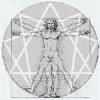B889 <=> B891 (BTG XLI The bokharian dervish, p. 890)
“’Highly esteemed Hadji! Until now I have been fully convinced that nowhere on the Earth does there exist an apparatus for the exact measurement of vibrations. Yet here I see so many of these measuring apparatuses.
“’How am I to understand this?
“’Where did you get them?’
“To this the venerable Hadji-Asvatz-Troov replied as follows:
“’These apparatuses for our experiments were made by my deceased friend Kerbalai-Asiz-Nuaran, and it is chiefly to them that I am indebted for all my attainments in the knowledge of the laws of vibrations.
“’Indeed,’ he continued, ‘there once existed on the Earth at the time of the flourishing of the great Tikliamish, all kinds of similar apparatuses, but at the present time there are none of these apparatuses, unless of course one reckons that, so to say, “childish bauble” now existing there in Europe by means of which vibrations can, as it were, be counted, and which there in Europe is called a “siren.” I even had such a siren when I began my elucidatory experiments.
“’This siren was invented two centuries ago by a certain learned physician named Zehbek and it was so to say perfected in the middle of the last century, by a certain Cognar-de-la-Tour.
“’The construction of this childish bauble consists in this, that a current of condensed air is directed from a pipe on to a revolving disc drilled with little holes, each hole exactly coinciding in size with the opening of the main air pipe; and as this disc revolves, the passage for the current of air, entering these holes from the main pipe, is alternately opened and closed.
“’And thus during the rapid revolution of this disc, successive shocks of air are obtained in the holes, and these produce an even-pitched tone of sound, and the number of revolutions recorded by the clock mechanism, multiplied by the number of the holes of the disc, should give the number of the vibrations of that sound made in the given interval of time.

